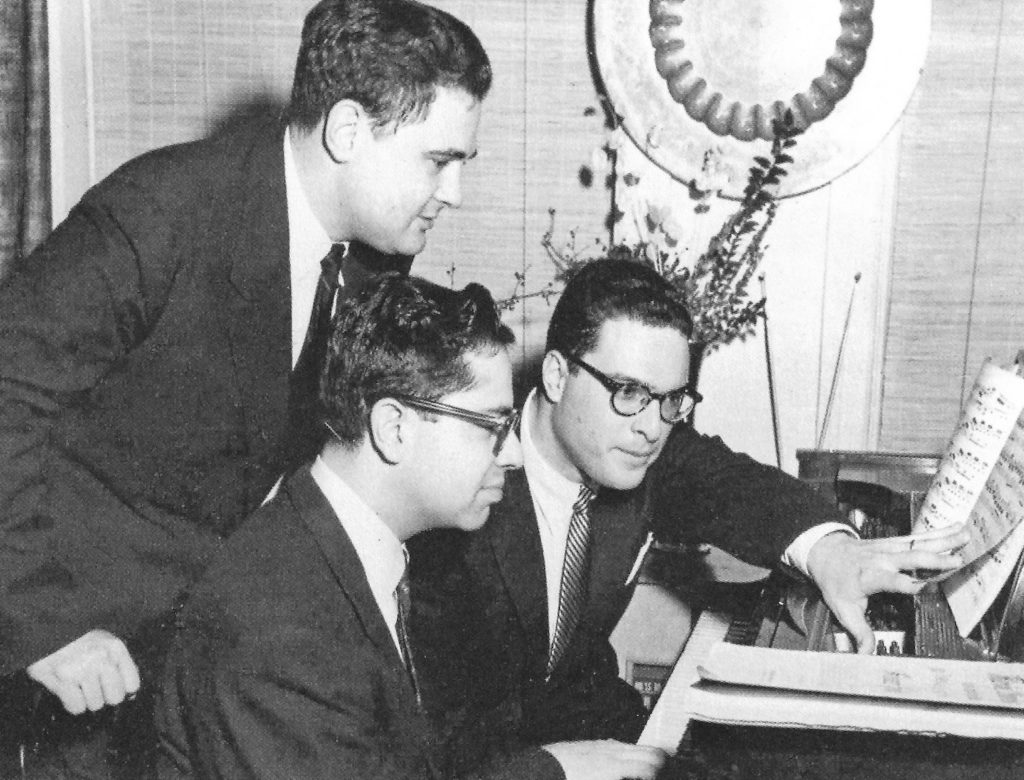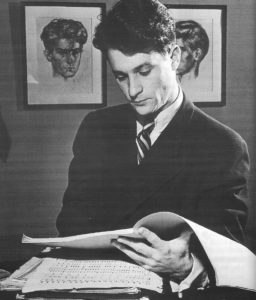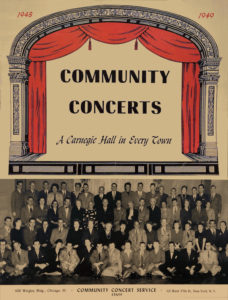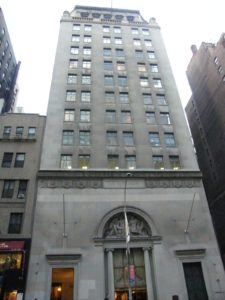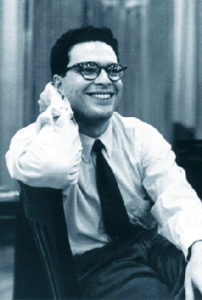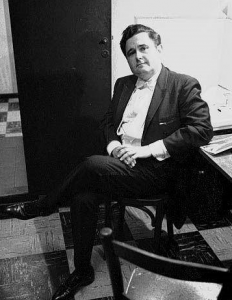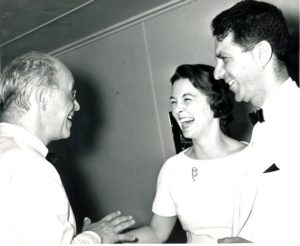In Time Magazine on December 2, 1957, one could read this humorous comment: “For some years, the most widely travelled US concert pianist has been an elusive fellow named Leogene Graffteiner. In several different incarnations last week he played Brahms in Boston, Schumann in Cincinnati and Mozart in Hamburg. Everywhere he was applauded by the critics. Leogene Graffteiner is really four pianists: Gary Graffman, Leon Fleisher, Eugene Istomin and Jacob Lateiner. The first three are close friends, and all share an extravagant admiration for an ancient Steinway concert grand known as ‘Old 199’. Because they pass it from one to another while touring in the US, they refer to its current player by a composite name. Graffman and Co. today are in the forefront of a group of young US pianists who have recently made the perilous leap from prodigy to professional artist.”
In fact, these four pianists were the spearhead of the small group which the press had the idea of calling, with their approval, the Outstanding Young American Pianists –otherwise known as the OYAPs. There is probably no other example of such a fraternal association in current musical life. The only reference one might find is the League of David, a secret society born in Robert Schumann’s feverish imagination, which was designed to bring together the most brilliant young composers of the time.
The main purpose of this informal association appeared to be that of helping each other to carve out a place in a somewhat hostile musical world. In fact, its goals went far beyond that. In a 1953 radio interview, included on a CD of the complete edition of his RCA recordings, William Kapell expressed the ideals of the younger generation in the aftermath of the horrors of World War II: “I think that the predominant feeling today is probably a reaction, a very strong reaction, to ugliness, to conflicts and to hatred in the world, to war!” As an artist, he added “to excessive commercialism in almost all the arts”. He then described the OYAPs and the fraternity which united them: “There is a group of young musicians who are very closely allied to each other, spiritually, musically and ideologically, who share pretty much the same basic philosophies. Of course, they have certainly different personalities, they have different ways of approaching their art, but the underlying thing is the same, always! We communicate with each other, we share with each other, and we try very hard to have this emotion and this feeling with an audience.”
Fifty years later, Istomin pointed out in his Great Conversations: “At that time, it was inconceivable for American critics, and for others too, that American pianists could have the refinement and musical depth of European pianists, their patina, their aura. The technique, yes! But not the musicality.” It was difficult to fight against prejudices. Two of the most deeply entrenched were that young pianists lacked maturity and in consequence played superficially, and that it was impossible for the same performer to excel in both Beethoven and Chopin.
Another OYAP fight was directed against stupid organizers and stingy managers. From the late 1940s to the 1960s, there were hundreds of associations in the United States which hosted Community Concerts, even in the smallest of towns. Each of the OYAPs gave several hundred recitals for this organization. The fees were modest, but they accepted with pleasure because it was part of their philosophy: music should not be reserved only for rich people living in large cities. The problem was much more to do with the concert programs. Ward French, the general manager, insisted that they play accessible works which were well-known if possible and, above all, short. If a work seemed too long, he would not hesitate to ask the artist to make cuts. All the OYAPs were determined to protest and to continue to offer coherent programs which were also musically ambitious. William Kapell even tried to play the Copland Sonata! Graffman, who had to give up Schubert’s Wanderer Fantasy because it was too long, recalled Istomin’s misadventures with Schumann’s Carnaval: “Brave Eugene had the audacity to program the Carnaval by Schumann one year, and when the cuts were proposed he reacted as if an Aztec had threatened to remove his vital organs. He held fast to every note and every repeat in spite of the fatherly advice (“Look here, Istomin, you play ball with us and we’ll play ball with you”) issued by Montezuma French, who subsequently extracted revenge by virtually ignoring Eugene’s existence as far as Community was concerned.” (1)
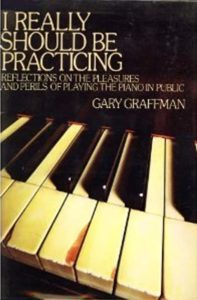 The greed and mean-spiritedness of the managers was incarnated in its notorious high priestess, Ruth O’Neill, portrayed by Gary Graffman in his autobiography I Really Should Be Practicing: “She was Judson’s right-hand lady and the treasurer of Columbia Artists. Miss O’Neill never failed to accompany the check with a little lecture on the virtues of frugality… She was genuinely upset if she caught us in any frivolous spending, like going to the movies… The later critic Cecil Smith once wrote that she had ‘a brain like a cash register’, and Willy Kapell was fond of saying, ‘Nickels roll out of her eyeballs’.” When the young pianists tried to suggest that they “were worthy of a higher fee,” she “would purse her lips and stare at the supplicant like a schoolteacher… and reply, in the sweetest, auntiest-like voice : ‘Dear, how old are you?’ ‘Why are you rushing things so? There’s plenty of time!’ This scenario was played out for a number of years. ‘How old are you?’ became an OYAP battle cry. After Eugene had gone through this routine for about eight years, he fantasized the possibility of one day hobbling in to the treasurer’s den, bald and gray-bearded, to ask the annual question. ‘Eugene, how old are you?’ the ancient crone behind the desk would quaver. ‘Ninety three’, Eugene would wheeze in reply. The thought became too much for him to bear, and he betook himself to the Hurok Management.” (2)
The greed and mean-spiritedness of the managers was incarnated in its notorious high priestess, Ruth O’Neill, portrayed by Gary Graffman in his autobiography I Really Should Be Practicing: “She was Judson’s right-hand lady and the treasurer of Columbia Artists. Miss O’Neill never failed to accompany the check with a little lecture on the virtues of frugality… She was genuinely upset if she caught us in any frivolous spending, like going to the movies… The later critic Cecil Smith once wrote that she had ‘a brain like a cash register’, and Willy Kapell was fond of saying, ‘Nickels roll out of her eyeballs’.” When the young pianists tried to suggest that they “were worthy of a higher fee,” she “would purse her lips and stare at the supplicant like a schoolteacher… and reply, in the sweetest, auntiest-like voice : ‘Dear, how old are you?’ ‘Why are you rushing things so? There’s plenty of time!’ This scenario was played out for a number of years. ‘How old are you?’ became an OYAP battle cry. After Eugene had gone through this routine for about eight years, he fantasized the possibility of one day hobbling in to the treasurer’s den, bald and gray-bearded, to ask the annual question. ‘Eugene, how old are you?’ the ancient crone behind the desk would quaver. ‘Ninety three’, Eugene would wheeze in reply. The thought became too much for him to bear, and he betook himself to the Hurok Management.” (2)
The OYAPs made mutual arrangements to use the best possible pianos. Alexander Greiner, head of Steinway Concert and Artists Department, asked his chief technician, Bill Hupfer, to introduce the OYAPs to the mysteries of piano craftsmanship. Hupfer explained the fine points of tuning, voicing, and mechanical regulation to them so that they would be able to ask local technicians to make the adjustments they wanted. This can be invaluable in some cases, but the OYAPs quickly understood that when a tuner was not competent, it was better not to ask him anything, as a botched-up intervention could render the instrument even worse than it already was. As soon as pianists moved away from New York, good pianos were a rarity, and good technicians even more so. The safest solution was to have a perfectly adjusted instrument shipped from New York.
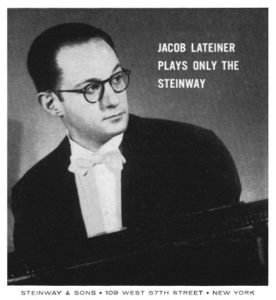 CD 199 (its Steinway Concert Department number) was the OYAPs’ favorite piano for at least ten years. Gary Graffman was particularly fond of it: “On 199 I felt almost as if I were playing a string instrument – as if it were possible to make a crescendo on a single note. It allowed me to lose myself completely in the music”. “One reason for Old 199’s popularity was its extraordinary versatility. In its heyday it could roar with me through a Tchaikovsky concerto in the vast reaches of Central Park’s Sheep Meadow with the same ease as, under Eugene’s ministrations, it meshed with the elegant sonorities of Isaac Stern and Leonard Rose in trio concerts at Carnegie Hall ; or, with Claude at its (ivory) keyboard, it movingly illuminated the complete cycle of Beethoven Sonatas at Hunter College.” “Our common dependency upon it reached such proportions that for a couple of seasons, in the mid-fifties, four of us – Leon, Eugene, Jacob and myself – joined forces and figured out a way to have 199 shipped around the country to meet us for our most important concerts.” (3) A timetable was established. When several pianists wished to have CD 199 available on the same day, an order of priority was established in a collegial business-like manner, taking into account the importance of the concerts and the quality of the piano available in the halls concerned. There was never any conflict, either in the distribution of dates or in the sharing of costs.
CD 199 (its Steinway Concert Department number) was the OYAPs’ favorite piano for at least ten years. Gary Graffman was particularly fond of it: “On 199 I felt almost as if I were playing a string instrument – as if it were possible to make a crescendo on a single note. It allowed me to lose myself completely in the music”. “One reason for Old 199’s popularity was its extraordinary versatility. In its heyday it could roar with me through a Tchaikovsky concerto in the vast reaches of Central Park’s Sheep Meadow with the same ease as, under Eugene’s ministrations, it meshed with the elegant sonorities of Isaac Stern and Leonard Rose in trio concerts at Carnegie Hall ; or, with Claude at its (ivory) keyboard, it movingly illuminated the complete cycle of Beethoven Sonatas at Hunter College.” “Our common dependency upon it reached such proportions that for a couple of seasons, in the mid-fifties, four of us – Leon, Eugene, Jacob and myself – joined forces and figured out a way to have 199 shipped around the country to meet us for our most important concerts.” (3) A timetable was established. When several pianists wished to have CD 199 available on the same day, an order of priority was established in a collegial business-like manner, taking into account the importance of the concerts and the quality of the piano available in the halls concerned. There was never any conflict, either in the distribution of dates or in the sharing of costs.
Friendship, sharing and healthy emulation were the driving forces of the group, as Fleisher attested in My Nine Lives: “We played for one another constantly. We were in and out of one another’s houses, trying out new repertory on one another, listening, playing, talking. We frequented the basement of Steinway hall, where the concert grands used to sit waiting, silent… We would each reserve the basement for two-hour practice slots. I would take it for a couple of hours, and then Gary, and then Eugene, and then Jake or Claude, and if we planned it right, we could tie up the room all night long. When we weren’t practicing, we went to concerts across the street to Carnegie Hall and afterwards went to the Carnegie Deli to eat pastrami sandwiches and deconstruct what we’d heard. We had a remarkable camaraderie. If we were competitive, it was healthy competition. We each had our own approach to the instrument, and making music for one another was the way we discussed it.” (4) Good humor reigned supreme and they enjoyed each other’s company immensely. Gary Graffman told Time Magazine: “When one of us three plays well, we don’t hear anything in Steinway’s basement, but when one of us plays badly, we hear loud screams and protests :’You pig, when are you going to decide to work?” (5)
In the early years, William Kapell was usually the first to take on the initiative of defending his colleagues. He thus obtained for Leon Fleisher, immediately after his triumph at the Queen Elisabeth Competition, a contract with Judson – who previously did not want to hear about him. Later on, Eugene Istomin took over. He was always available for his colleagues, lending an uncompromising ear to their playing, seeking out engagements for those who were lacking them, or putting them in touch with great musicians to whom he was close (in particular, Casals and Horowitz). In 1958, when Steinway, accused by some associations of encouraging the slaughter of elephants to obtain the ivory for its keyboards, decided to replace it with a synthetic material, Istomin mobilized the OYAPs to advocate, in vain, that concert pianos be exempted from the ban. He remained devoted to these fights as long as his influence in the American musical world allowed him to be an effective champion, and if he considered that he could be of support.
Who were the OYAPs? In addition to Istomin, Kapell, Fleisher, and Graffman, who were the nucleus of the group, there was Jacob Lateiner, Claude Frank, Lilian Kallir, and Seymour Lipkin. Julius Katchen, who complained about the obsessive spirit of competition in America, would certainly have been one of them if he had not left so soon to settle in France. The spirit of exclusion was alien to the OYAPs. Van Cliburn, Rosen and Janis were not really full members for various reasons, but they were still considered to be part of the family, like distantly-related cousins. Other pianists who were born a few years later, such as John Browning, Richard Goode, James Tocco, André Watts and Joseph Kalichstein, maintained privileged relationships with their elders. The last pianist to really assert himself in this lineage was Emanuel Ax, who was duly knighted by Eugene Istomin after he won the Rubinstein Competition in 1974. Yefim Bronfman could also claim membership!
The association was intensively active from the late 1940s to the mid-1960s. The internationalization of careers, family obligations, or injuries which forced some of the members to stop playing, loosened the ties – but they never broke. In December 2001, when Istomin invited Fleisher, Graffman, Rosen, Ax, and Bronfman (in chronological order of birth!) to take part in his Great Conversations at the Library of Congress, we can still feel their sense of complicity.
Today, the word OYAP remains in use in the United States to designate a very promising young pianist, but it is doubtful that the musical and human ideals which animated the first generation can ever be duplicated.
Documents
Two less famous OYAPs who do not have a dedicated article on this website: Jacob Lateiner and Lilian Kallir
Prokofiev. Toccata Op. 11. Jacob Lateiner.
.
Chopin. Ballade No. 1 in G minor Op. 23. Lilian Kallir.
.
Notes
- Gary Graffman. I Really Should Be Practicing, page 124
- Gary Graffman. I Really Should Be Practicing, page 99
- Gary Graffman. I Really Should Be Practicing, page 196 & 188
- Leon Fleisher. My Nine Lives, page 64
- Time Magazine. December 2, 1957

